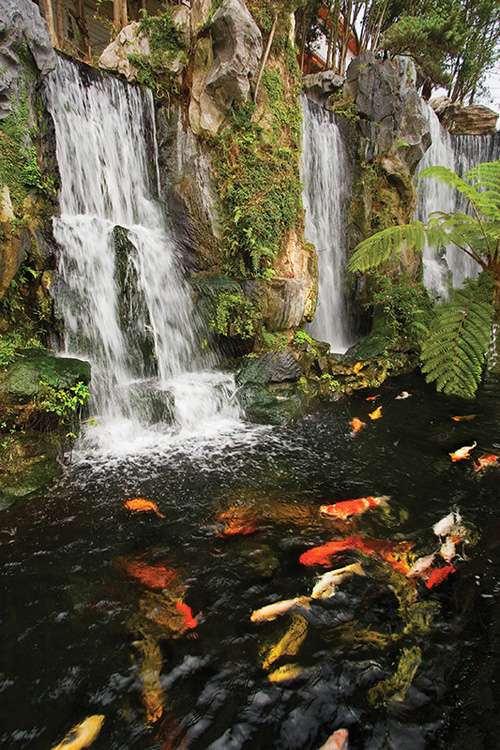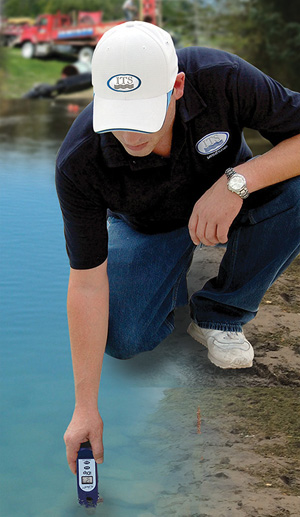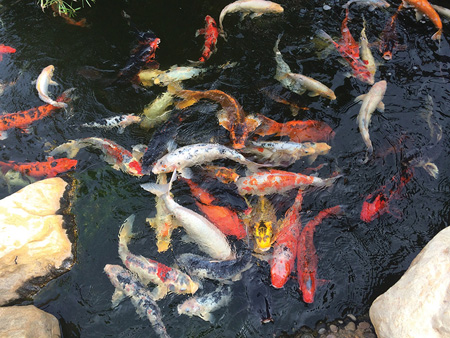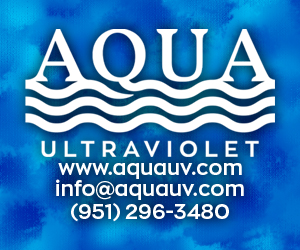
Most people believe that if their pond’s water is clear, it is also clean and viable. However, this is not always the case.
It’s important to know that biological and chemical changes in water are often not visible. Only through proper testing can the true quality of water be determined. Poor water quality leads to stress and health problems that can be avoided with proper care.
When a pond first opens, it should be tested weekly for the first four to six weeks, regardless of what kind of aquatic life might be present. It is especially important to test for ammonia, nitrite and nitrate during this period, because the pond needs to establish a natural biofilter. After this initial period, water parameters are established so that the pond can be tested monthly, provided there are no widespread external influences on the pond. If you notice unusual odors, aquatic sickness or death of aquatic life, test your water immediately. When testing, always take a water sample about 12 inches below the surface and be sure to complete testing within 30 minutes of collection.
Twelve Common Test Parameters
Here’s an alphabetical guide to some of the most common test parameters you’ll need to deal with in and around the pond.
Alkalinity, often referred to as carbonate hardness, German carbonate hardness or KH, is the measure of carbonate and bicarbonate concentrations in your water. Essentially, it is the measure of the ability of water to resist rapid changes in pH. It is not the same as pH, because water does not need a high pH to have high alkalinity. Measurements in an established pond can range from 50 ppm to 200 ppm as CaCO3, with 100 ppm being ideal. Over time, alkalinity is naturally decreased through bacterial action. If the alkalinity level is high, perform a routine water change with lower-alkalinity water, or add a mild acid. To raise alkalinity, calcium carbonate (baking soda) can be added.
Ammonia is typically introduced through waste released by fish gills. It can also form from decaying plant material in the pond or uneaten food left in the water. Ammonia can exist as free ammonia, which is poisonous to fish, or as ionized ammonia, which is less harmful. It can have detrimental effects on fish by hindering the absorption of oxygen from the water. If the water becomes polluted with ammonia, regular water changes need to take place to reduce the concentration. In the early stages of establishing a pond, it could take several weeks before the ammonia level in the water begins to drop. The level of ammonia should be zero, but up to 0.5 ppm NH3 is acceptable. Ammonia is much more toxic if the pH of the water is above 8.0.
Chlorine (free and combined) is widely used in the disinfection process of city tap water. The acceptable concentration in a pond is zero, but even at low levels of 0.05 ppm, it can be harmful for aquatic life, causing skin and eye irritation, gill agitation or death. Chlorine is known to react with organics in water to form trihalomethane (THM), which is a suspected carcinogen. It is also used as an oxidizing agent for manganese, iron and hydrogen sulfide.
Green water refers to the algae blooms present in pond water. This can affect the pH of the water in the presence of plants. Plants produce nutrients directly from carbon dioxide dissolved in the water. They consume carbon dioxide during the day, thus removing it from the water and causing alkaline carbonates and bicarbonates to dominate and raise the pH. Major algae blooms can cause a pond’s pH to fluctuate tremendously during a 24-hour period.
Dissolved oxygen is a measure of oxygen in water, which is crucial for fish and other pond life. Water temperature controls the maximum amount of oxygen that can be dissolved. Warm water holds less dissolved oxygen than cold water. Levels of dissolved oxygen below 6 mg/L can have harmful effects on aquatic life. Lack of dissolved oxygen will cause fish death, but it can be controlled by algae and aquatic plant growth. Aeration devices are commonly used to increase dissolved oxygen.
E. coli bacteria are a species of coliform bacteria that stems from the waste of humans or animals. High numbers can be caused by septic systems, runoff from farms or wildlife. E. coli bacteria in ponds should have fewer than 126 colonies per 100 mL of water. Levels can be reduced by redirecting runoff, limiting wildlife accessibility and sustaining septic systems nearby.
Total hardness, sometimes referred to as general hardness, is the total quantity of dissolved minerals in water. Calcium and magnesium are the primary minerals associated with total hardness. The optimal range is 60 to 160 ppm as CaCO3, but higher levels typically do not affect the health of a pond.
Green water refers to the algae blooms present in pond water. This can affect the pH of the water in the presence of plants. Plants produce nutrients directly from carbon dioxide dissolved in the water. They consume carbon dioxide during the day, thus removing it from the water and causing alkaline carbonates and bicarbonates to dominate and raise the pH. Major algae blooms can cause a pond’s pH to fluctuate tremendously during a 24-hour period.
[box]Related Content | So You Still Want a Crystal Clear Pond? Revisiting Undergravel Filtration[/box]
Nitrite is the primary breakdown product of ammonia, and as it increases, it is very poisonous to fish. It is a skin irritant and will prevent fish from absorbing oxygen from the water. High nitrite level concentrations in the pond can be reduced by regular, partial water changes. Nitrite is an odorless, colorless substance, and the ideal level in your water should be zero, with acceptable levels up to 0.25 ppm NO2.
Nitrate is produced from breaking down the nitrite through bacteria action. Nitrate is not especially harmful to freshwater fish, but it is a strong plant fertilizer and can cause the growth of algae. The levels of nitrate should be controlled to help reduce algae blooms. The optimal level of nitrate in water should be between 20 to 60 ppm NO3, and this can be controlled through partial water changes. It is eventually broken down into nitrogen.

pH is a measure of acidity and can be separated into three categories: pH 0 — 6.99 (acidic), pH 7.0 (neutral) and pH 7.01 — 14.0 (alkaline). In general, pH is not a problem for ponds, but it influences the toxicity and concentration of ammonia. Water above a pH of 7.01 with increased water temperatures causes the presence of more free ammonia. The higher the pH and water temperature, the greater the percentage of free ammonia. The ideal pH range is 6.8 to 7.8 for pond water.
Phosphates are needed by both plants and fish to stay healthy. However, high levels of phosphate cause algae blooms and can also be an indication of pollution from fertilizers. The higher the phosphate levels are, the more aggressively the algae tend to bloom. Phosphates cause weed proliferation and muck. There are chemical and nonchemical methods for removing phosphates from pond water. The ideal level is less than 0.3 ppm.
Salinity, salt or sodium chloride (NaCl) is important tool for health care and maintenance of fish, and it can also be helpful in treating parasites. Salt concentrations between 3 to 5 ppt will dehydrate and upset parasites’ cells. Nitrite can be detoxified at a salt concentration of 3 ppt, and algae can be controlled at concentrations of 25 ppt and higher. Plant damage may occur as the concentration of salt increases, so you’ll want to be mindful of this as you refine the chemistry of your pond.
Testing Equipment
There are two common testing methods used in the pond industry: electrochemical and colorimetric. Electrical measurements can be used to detect and determine some analytes, which is known as electrochemical analysis. Electrochemistry involves using electrodes placed in a water sample to measure an electrical potential (voltage) or a current related to the concentration of a specific analyte. This method can be used in the field, but frequent calibrations using multiple standard solutions and special handling care are required. Lab-quality, handheld portable probes are suitable for field use if cared for properly. Electrochemical testing is limited to a small number of tests, which include total dissolved solids (TDS), pH, temperature, conductivity, salinity, oxidation reduction potential (ORP) and dissolved oxygen.
To determine the concentration of chemical elements and compounds with the aid of a color reagent is known as colorimetric analysis. There are four basic methods of colorimetric analysis used in water testing: colorimeters and photometers, titrations, a reagent with a color chart comparator and visual test strips.
Testing with a photometer accompanied by reagent is the most sensitive and accurate of all the colorimetric testing methods. This method involves photometers using colorimetric or precipitation chemistries to measure color intensity (or precipitate) by an electronic instrument. The instrument measures transmission of light at a given wavelength through the water sample after reacting with reagent. It then produces a result through algorithms based on the color change. It’s quick and accurate, and there’s no visual color matching or digital reading, so it’s great for field use. However, it can be costly, and powders and tablets don’t dissolve fully in colder waters. Also, forgetting to zero it out correctly may produce false results.
Titration analysis includes colorimetric chemistries that require visual color-change interpretations. Test procedures consist of adding drops and swirling until a color change is visible. All results are determined by the color changes. The results are generally accurate, and this method is portable. But, this test is extremely technique-driven, with an emphasis on counting drops, calculations and visual color reading. Furthermore, liquids cannot be stored in cold or hot weather extremes.
To perform colorimetric testing using reagent with a color chart comparator, fill a vial with a specific sample amount of water. Then add an exact amount of liquid reagent and swirl until the water won’t change colors any further. After the color change has been completed, results are compared to a color chart. This is a more inexpensive, simpler test that is great for field use. However, the vials may not be very durable, and often the reagents have stability issues. There can also be minimum resolution of color, so you have to have good visual judgment to interpret the results.

To use visual test strips with a color chart, dip a test strip into a predetermined sample amount of water for a specific amount of time. Some strips require a back-and-forth motion while immerged, while others don’t. The strip is then removed and left to sit for an exact amount of time. The results are compared to a color chart. This method is quick, easy, inexpensive and great for screening, with a good shelf life. But, like colorimetric testing using reagent, it requires precise visual judgment to determine the results.
Here are some quick questions to ask yourself when choosing the right equipment and procedure. What is the cost per test? (They range anywhere from $0.02 to $0.30 and all the way up to $10.) What is the time it takes to perform a test? (It can range anywhere from 30 seconds to five minutes.) How easy is it to use, and its it appropriate for your intended goal? Do you, as a tester, require training to perform testing correctly and accurately? What is the portability and stability of the test kit and its reagents?
Photometer Advancements
There have been new and recent technological advancements in photometers. Improved software now allows the meter to read optical densities of the reacted solutions, allowing them to be more accurate. Long-life LEDs have replaced filament lamps, increasing their reliability. Solid-state light sensors have been installed, increasing the accuracy of the meter. They are now battery-operated, making them much more reliable and accessible for field use. Waterproofing the meters has extended their life expectancy from months to years, enhancing them for field use. Installing digital interfaces with smart phones has revolutionized testing, making results easier to read, eliminating the need for manual computation and adding technological benefits such as time, date and GPS stamping. These devices are defined as microelectronics, which are accompanied by reduced costs, giving you lab-quality results in the palm of your hand.


